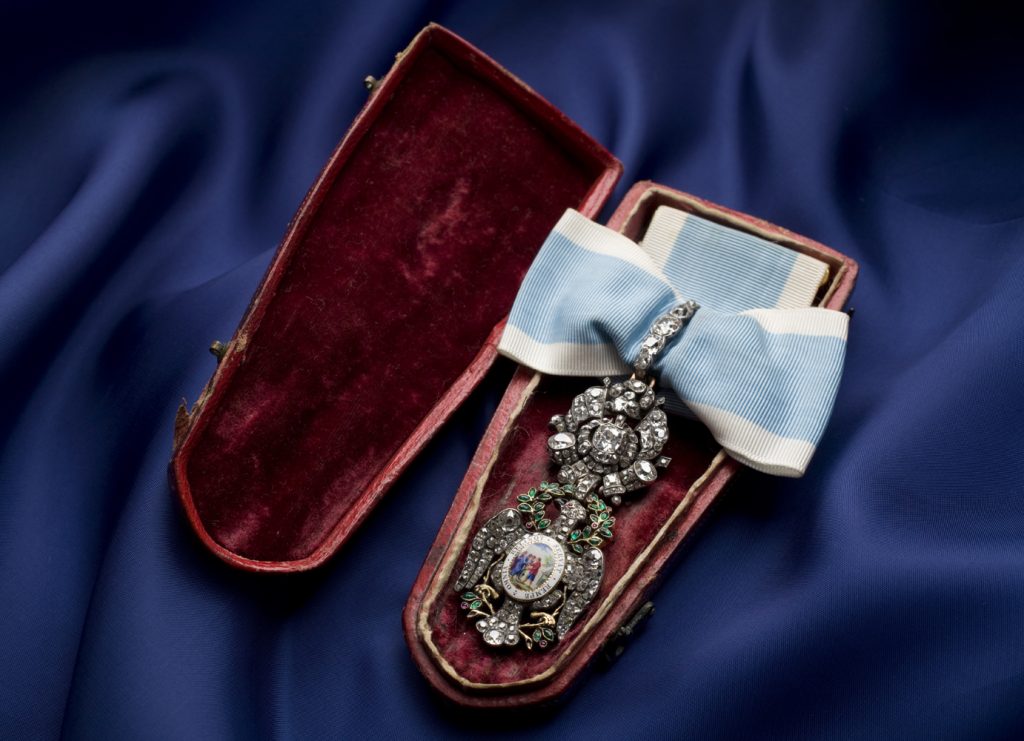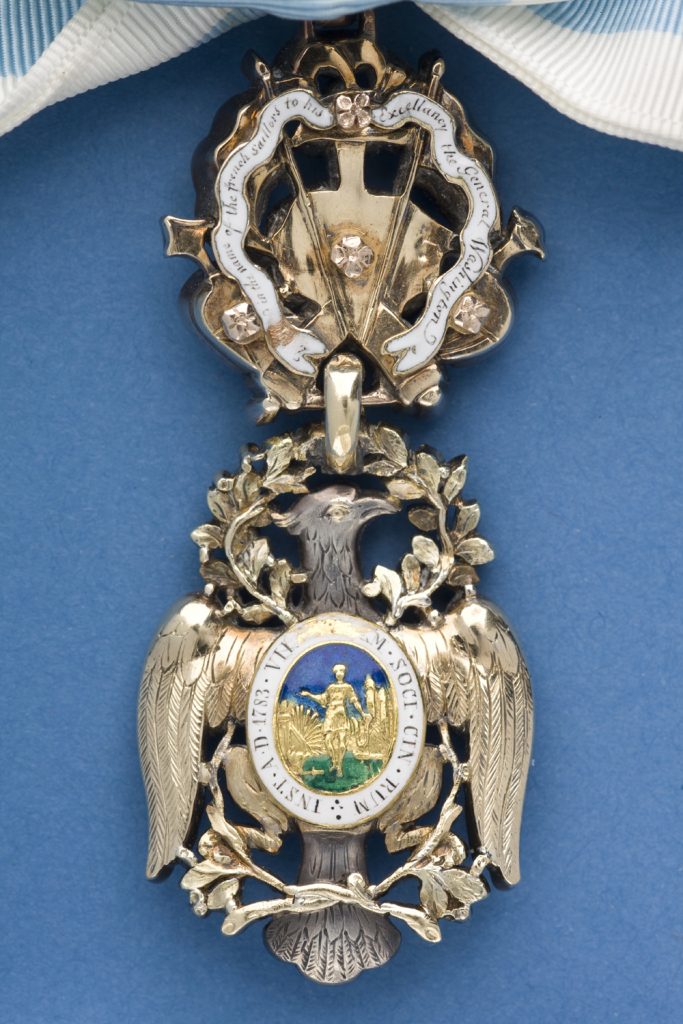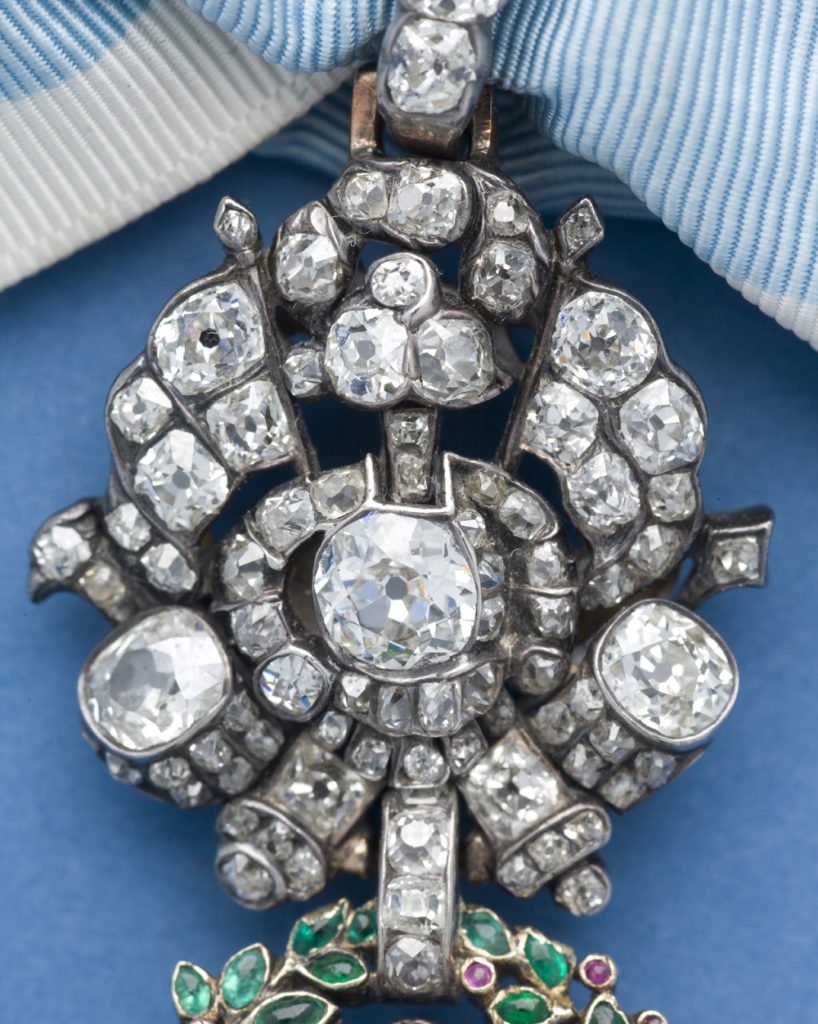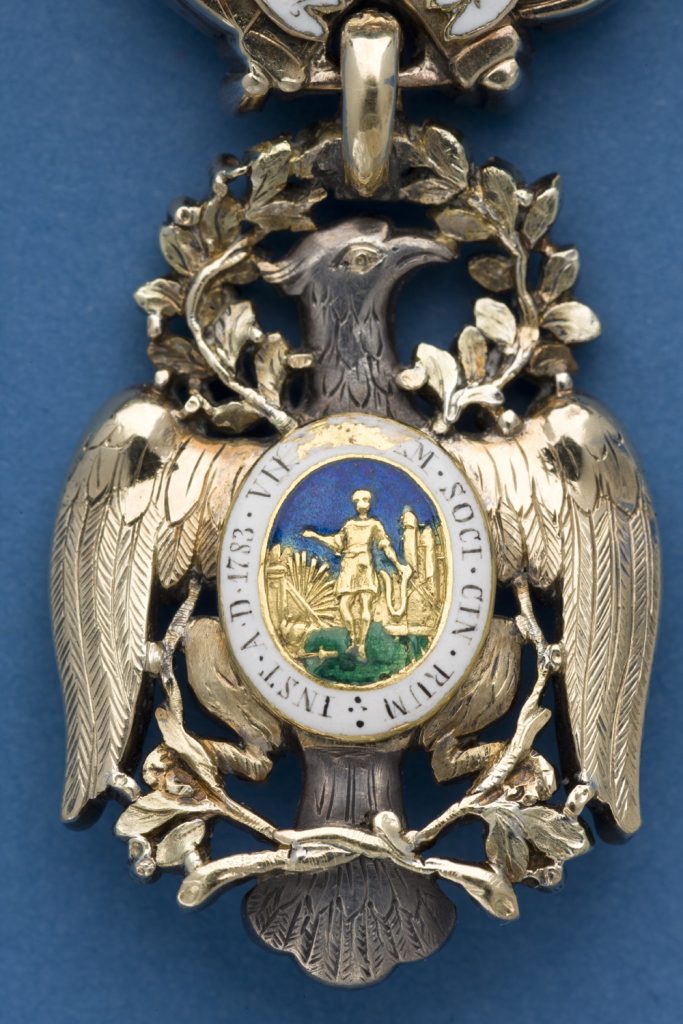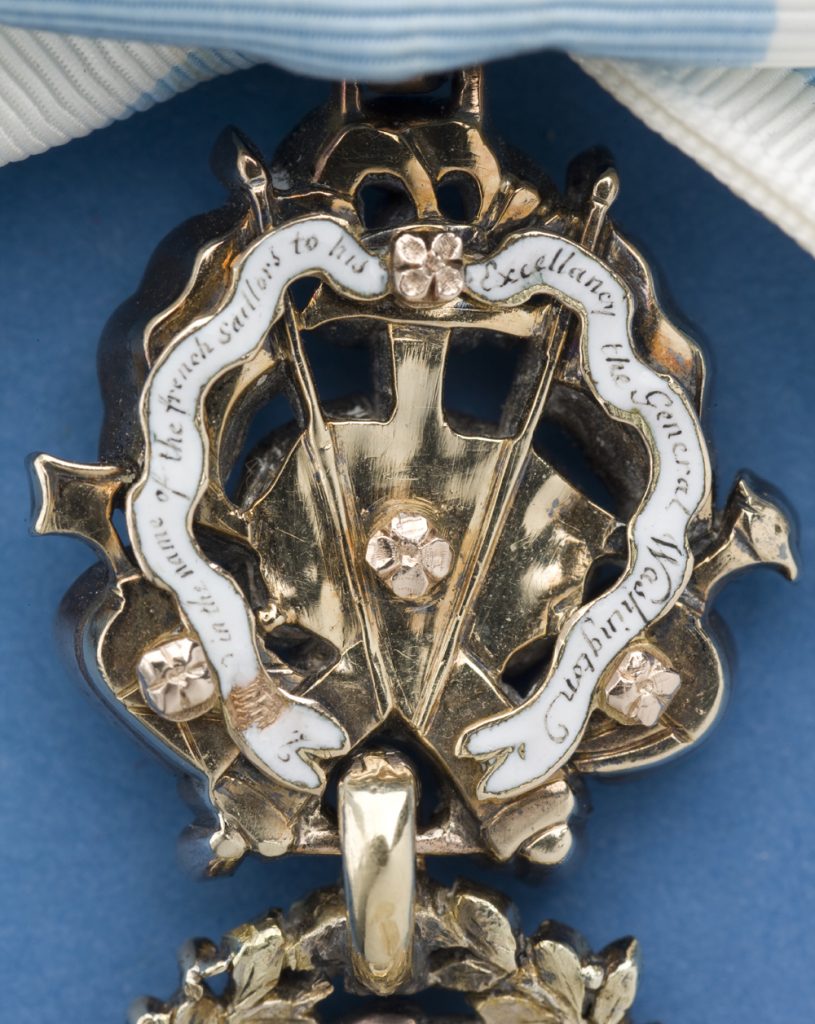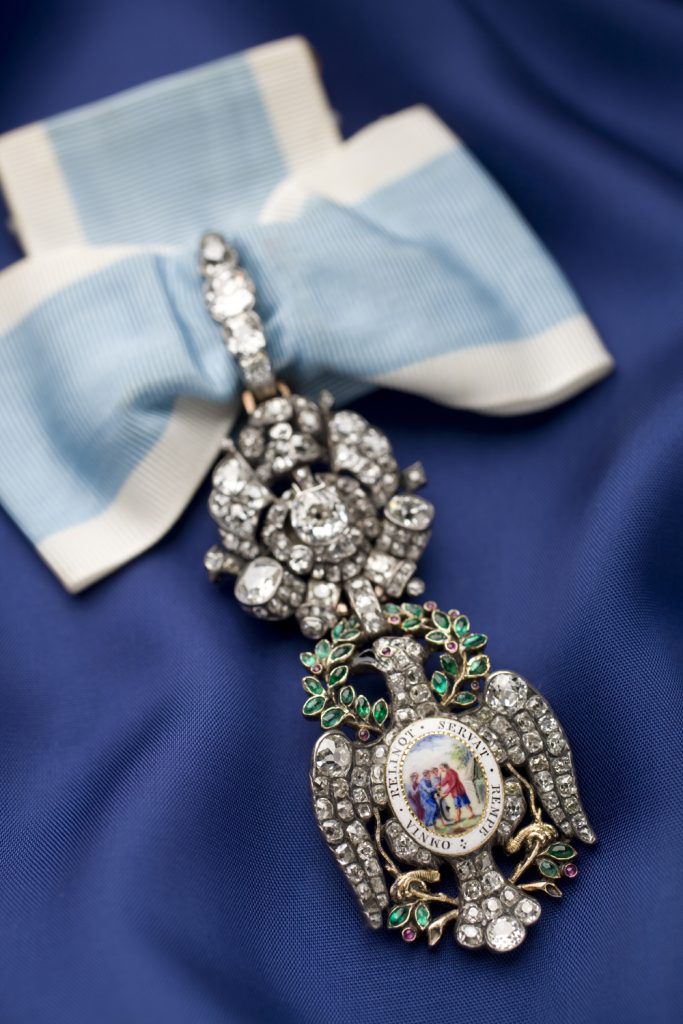 The most important piece of historic American jewelry is the Diamond Eagle, the badge of the president general of the Society of the Cincinnati. Made in Paris in 1784, the Diamond Eagle was presented by French naval officers to George Washington, the Society’s first president general. It has been worn by Washington and each of his successors as president general, including Alexander Hamilton and Charles Cotesworth Pinckney, up to the present day. The spectacular bejeweled Eagle—adorned with 198 diamonds, emeralds and rubies—symbolizes the creation of the American republic, the importance of French contributions to the cause, and the commitment of the patriots’ descendants to preserving the memory of our Revolution.
The most important piece of historic American jewelry is the Diamond Eagle, the badge of the president general of the Society of the Cincinnati. Made in Paris in 1784, the Diamond Eagle was presented by French naval officers to George Washington, the Society’s first president general. It has been worn by Washington and each of his successors as president general, including Alexander Hamilton and Charles Cotesworth Pinckney, up to the present day. The spectacular bejeweled Eagle—adorned with 198 diamonds, emeralds and rubies—symbolizes the creation of the American republic, the importance of French contributions to the cause, and the commitment of the patriots’ descendants to preserving the memory of our Revolution.
The Diamond Eagle is the finest example of the Society of the Cincinnati insignia. Pierre L’Enfant, a French-born artist and military engineer, designed the insignia, which became known as the Eagle, in the early summer of 1783. Full of enthusiasm for his adopted country—he even Americanized his name to “Peter” around this time—L’Enfant was determined to create a distinctive badge for the new society. He envisioned a double-sided insignia in the shape of the American bald eagle, with oval medallions on the bird’s chest depicting scenes of Cincinnatus, the Society’s namesake. As proscribed by the Institution, or founding document, of the Society, the insignia would be suspended from a blue-and-white ribbon, colors “descriptive of the Union of France and America.” Society leaders approved the design in June 1783 and commissioned L’Enfant to have the first Eagles made.
L’Enfant, who insisted that only French craftsmen had the skill and experience to produce the insignia, set sail from Philadelphia for Paris in the fall of 1783. On December 8, he arrived at Le Havre on the northwest coast of France. L’Enfant traveled immediately to Paris, where he arranged for the first Eagles to be made. He commissioned goldsmiths Nicolas Jean Francastel and Claude Jean Autran Duval to produce 225 gold insignias decorated with enamel and suspended from a silk ribbon. These standard Eagles would be sold or distributed to Society members in the United States and France beginning in 1784.
No written evidence has been found demonstrating that L’Enfant’s plans included the Diamond Eagle, but it had to have been commissioned early in his trip to give the craftsmen enough time to complete the job before L’Enfant returned to America in the spring. Francastel and Duval collaborated on the Diamond Eagle, as they did the other gold insignias. Duval cast the Eagle while Francastel, the more experienced goldsmith, finished the intricate hand carving work, which is particularly evident on the reverse of the Diamond Eagle. They probably employed one or more unidentified jewelers to set the stones on the Eagle. (The silver settings around many of the diamonds are tighter and cleaner than the gold settings around the emeralds and rubies, pointing to an apprentice or less experienced jeweler who set the colored stones.)
With 160 diamonds of various sizes and cuts, 28 marquis-shaped emeralds, 10 rubies, gold, silver, and enamel, creating the Diamond Eagle was no small task. During the late eighteenth century, diamonds and other precious stones were in relatively short supply. Given the short amount of time in which French jewelers had to create the Diamond Eagle—L’Enfant was in France for three and a half months—it is possible that some of the diamonds used in the Eagle came directly from the stores of Louis XVI, who signaled his approval of the Society in mid-December 1783. The larger and whiter diamonds in the Eagle appear to have originated in Golconda, India, while the smaller, off-color diamonds were probably mined in Brazil. (India was the chief source of diamonds used in European jewelry in the early modern era, while Brazilian diamonds had only recently entered the market when the Diamond Eagle was made.)
L’Enfant undoubtedly provided Francastel and Duval with his watercolor design of the Society of the Cincinnati insignia as a guide for the general form of the Diamond Eagle, but its decoration sets it apart from other Eagles. The wings are formed of diamonds rather than the plain cast gold surfaces of the standard Eagles. The shape and size of each stone was chosen to create the appearance of feathers on tapered wings. The wreath and branches on the Diamond Eagle are comprised of emeralds and rubies set in gold—while these features on the standard Eagles are decorated in green and red enamel. The two well-known medallions depicting Cincinnatus appear on both sides of the Diamond Eagle, with the scene on the obverse expressed in the most detailed and artistic enamel work of any known Society insignia.
The symbolism incorporated into the nearly circular trophy section connecting the Eagle to the ribbon is unique to this piece. What at first appears to be a random and merely decorative assortment of diamonds becomes, upon closer inspection, a well-thought-out assemblage of military objects that represents the ties between the United States and France that helped win American independence. Two unfurled flags dominate the left and right sides of the top of the trophy. A poppy flower, a symbol of death or sleep, appears between the two flags—a possible tribute to the soldiers and sailors who gave their lives during the Revolutionary War. The head of a rooster, a widely used symbol of France, pokes out below the left flag. Towards the bottom of the trophy, on the right and left sides, two large, cushion-cut diamonds with tiers of small, square diamonds form epaulets with fringe. The ends of two cannon angle beneath the epaulets, formed by two square French-cut diamonds and several small round diamonds. The inscription on the white enamel banner on the reverse of the trophy memorializes the ultimate purpose for the Eagle: “Donated in the name of the french sailors to His Excellancy the General Washington.”
The Diamond Eagle was originally suspended from a long, silk, blue-and-white ribbon. A folded, shorter piece of ribbon was fed horizontally through the silver loop adorned with diamonds at the bottom of the long ribbon. At the top of the long ribbon, the original metal clasp—consisting of a horizontal bar and ring—allowed Washington to secure the Eagle through a buttonhole on the left side of his coat. The Diamond Eagle was presented in what is said to be the original red morocco case, a coffin-shaped hinged box in which the Eagle fit with the top and sides of its ribbon folded.
Who commissioned the Diamond Eagle? It appears that the Eagle was at least partially complete by mid-February 1784, when Charles Hector, comte d’Estaing, the newly elected president of the French branch of the Society and the highest-ranking French naval officer of the Revolution, wrote to the former French ambassador Anne César, chevalier de La Luzerne, about its manufacture. In the letter, dated February 18, d’Estaing described his knowledge of the Diamond Eagle: “Learning by chance that an Eagle set with diamonds had been made for General Washington, I won over the jeweler. I obtained this Cincinnatus; I had a trophy and a banderole added, saying thereon that it was presented to His Excellency General Washington by French sailors. … My little token nautically presented will acquire some value since it will be placed in the buttonhole of General Washington.” It would seem, from this account, that d’Estaing was not aware of the initial commissioning of the Eagle, whose design appears to have originally included only the Eagle body, with the elaborate diamond trophy and enamel inscription above the body added later at d’Estaing’s request. How and when d’Estaing learned of the existence of this diamond-encrusted eagle, whether just prior to writing to La Luzerne in February or weeks or even months earlier, is uncertain.
If d’Estaing was not involved in the initial commissioning of the Diamond Eagle, who led the effort to have it made? It is possible that L’Enfant, who liberally ordered scores more Eagles than the Society of the Cincinnati authorized, was intimately involved in the creation of the Diamond Eagle. Foreshadowing part of the Diamond Eagle’s design in June 1783 when L’Enfant completed his watercolor drawing for the standard insignia, he suggested that “the head and tail of the eagle will be of silver or enameled in white … Those that can afford it could have in diamond everything that is white.” Seven months later, he was in Paris visiting French officers to encourage their interest in Society membership—some of whom may have encouraged L’Enfant to have a special token made for Washington.
It may also be possible that the marquis de Lafayette, the heroic French general and beloved friend to Washington, had a role in the creation of the Diamond Eagle. Washington, while informing Lafayette of L’Enfant’s impending visit to France, wrote: “Major L’Enfant … has undertaken to get the Order of the society executed in France. He has directions to deliver you one of the first that are compleated, and you will please also call on Him for as many as You may want.” With this authorization from Washington, Lafayette may have worked with L’Enfant to have an elaborate insignia made to honor their former commander in chief. The beginning of d’Estaing’s February 18, 1784, letter to La Luzerne suggests Lafayette’s involvement: “The sojourn of M. L’Enfant was several times prolonged but my own part was delayed. I hope that my requests and their motives might be entrusted to Major L’Enfant. His mission had its difficulties. This is explained by the way he worked and by the influence of the advice of the Marquis de La Fayette.” D’Estaing may be alluding to his own efforts to secure membership in the Society of the Cincinnati for French naval officers, but he also may be referring to the Diamond Eagle. If the Eagle was ultimately the result of an unplanned collaboration between L’Enfant, Lafayette and d’Estaing, it was probably inspired by their reverence for Washington. D’Estaing expressed such sentiments in a letter written to the former American commander in chief on Christmas Day 1783: “Our common friend, the Marquis de la Fayette, and I talk frequently of you. … We many times repeat to each other that among the celebrated men whom antiquity boasts of, none have performed actions of such difficulty and importance as those which you just so gloriously terminated.”
However it was originally created, the Diamond Eagle ultimately became the gift of French naval officers, led by d’Estaing. On February 26, 1784, d’Estaing penned the letter that accompanied the Eagle to America. “It is in the name of all the French Sailors,” d’Estaing wrote to Washington, “that I take the Liberty to request Your Excellency to accept of an American Eagle, expressed rather than embellished by a French Artist.” The likely motive for the French sailors’ gift—aside from their personal sentiments regarding Washington—was to advance their case for membership in the Society. The Society’s Institution was vague about the membership of a potential French branch. The document acknowledged that Jean Baptiste Donatien de Vimeur, comte de Rochambeau, and “the Generals and Colonels” of the French army would be considered members, but it named only six senior officers of the French navy as members. Many Frenchman who were already involved with the Society found the inconsistency puzzling, if not offensive. D’Estaing was “mortified” at the slight; Lafayette considered it “Impolitic;” and L’Enfant branded it “prejudicial.” At the organizing meeting of the French Society on January 16, 1784, L’Enfant took it upon himself to accept French naval officers’ claims to membership and to distribute Eagles to them, but no official word from America had come.
While d’Estaing’s February 1784 letter does not give a specific reason for the gift of the Diamond Eagle, he emphasized that the Eagle symbolizes the French forces’ role in the American fight for liberty: “The efforts of a patriot army were irresistible, Seconded by the King’s Troops, who have shewn themselves by their discipline and conduct, worthy of the choice of His Majesty, his Navy has made every thing possible.” D’Estaing concluded by entreating Washington to accept the Diamond Eagle with the “Sentiments of the most profound admiration and attachment.”
L’Enfant returned to America in the spring of 1784, departing France on March 16 and arriving in New York on April 29—a journey of forty-three days. He then traveled to Philadelphia in time to present the Diamond Eagle to Washington on May 11, 1784, during the first general meeting of the Society of the Cincinnati. Washington’s acceptance of the extraordinary gift—much more elaborate than the gold Eagle he had ordered for himself—was, in part, a political decision. The Society had been embroiled in controversy since L’Enfant’s departure. Its critics charged that the hereditary and seemingly exclusive organization was intended to establish an American aristocracy like the British one that had just been overthrown, and demanded that the Society disband.
The Diamond Eagle, coupled with the earlier news that King Louis XVI had decreed his approval of the Society of the Cincinnati and his permission for French officers to wear its insignia, carried with it the weight of French enthusiasm for the Society that made it all but impossible to disband the fledgling brotherhood. Indeed, d’Estaing confided in La Luzerne in mid-February 1784 that “this trifle can neither displease nor embarrass, nor can it be refused since it is offered in the name of all my comrades.” And so Washington replied to d’Estaing on May 15, thanking him and his French brethren for the “absolutely inestimable” gift. The May General Society meeting also clarified the membership questions raised for French naval officers. On May 17, Washington wrote to d’Estaing, declaring that “’All the Admirals and Captains of the Navy, ranking as Colonels, who have co’operated with the Armies of the United States’—are litterally included, and it is the expectation also of the Society that it will effectually comprehend all the Officers of the French Navy who have been particularly recommended by your Excellency.”
Despite the significance and beauty of the Diamond Eagle, Washington appears to have worn it only on very special occasions. Aside from the few times when he may have worn it in his official capacity as president general of the Society, the only other event for which he regularly wore the Diamond Eagle was his annual birthday ball. In 1797 Henrietta Liston, wife of the British minister to the new nation, observed Washington wearing his blue-and-buff Continental Army uniform with “the Cross of Cincinatus at his breast in diamonds.” Two artists, John Ramage and Edward Savage, painted portraits of Washington from life in which he wears a Society Eagle, but none of the portraits shows the insignia closely enough to determine if it is the Diamond Eagle.
When Washington died on December 14, 1799, the Diamond Eagle was among his personal possessions at Mount Vernon. His widow, Martha, sent the Eagle to Alexander Hamilton, who was elected the following year as Washington’s successor as president general of the Society. Hamilton’s time in that office was cut short in 1804, when he succumbed to wounds sustained in a duel with fellow Society member Aaron Burr. When Charles Cotesworth Pinckney of South Carolina was elected the third president general in 1805, Mrs. Elizabeth Hamilton forwarded the Diamond Eagle to him, just as Martha Washington had sent it to General Washington’s successor. Inspired by this “testimonial of respect for the immortal Washington,” Pinckney grew to consider the Diamond Eagle, which had been privately owned by the first three presidents general, as the rightful property of the Society itself. Pinckney formally transferred the Diamond Eagle to the Society in 1811—only the second object to be acquired by the Society for what would later become its museum collections. Each man who has followed Washington, Hamilton and Pinckney in the office of president general over the last two centuries has worn the Diamond Eagle, a treasured symbol of the bonds between the Revolutionary War soldiers and sailors who won American independence that continue among their descendants in the Society of the Cincinnati today.
View More Society Eagles
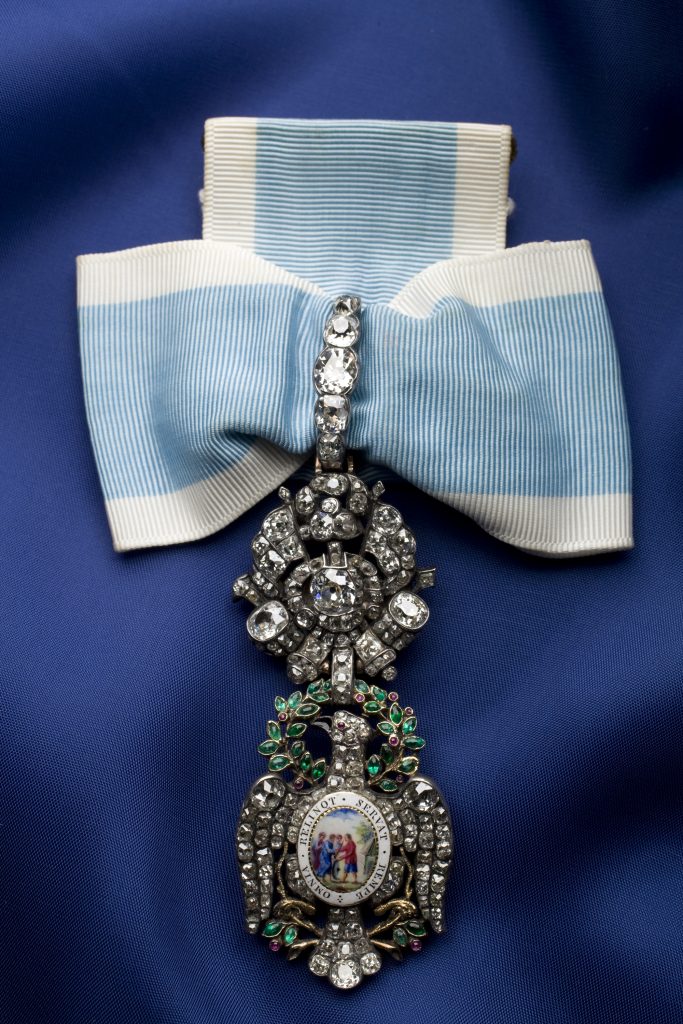
Diamond Eagle of the Society of the Cincinnati
Nicolas Jean Francastel and Claude Jean Autran Duval, Paris
1784The Society of the Cincinnati Collections
The double-sided Diamond Eagle consists of an eagle-shaped body surmounted by a circular trophy suspended from a blue-and-white silk ribbon. The gold-and-enamel body and silver trophy are adorned with 198 diamonds, emeralds and rubies.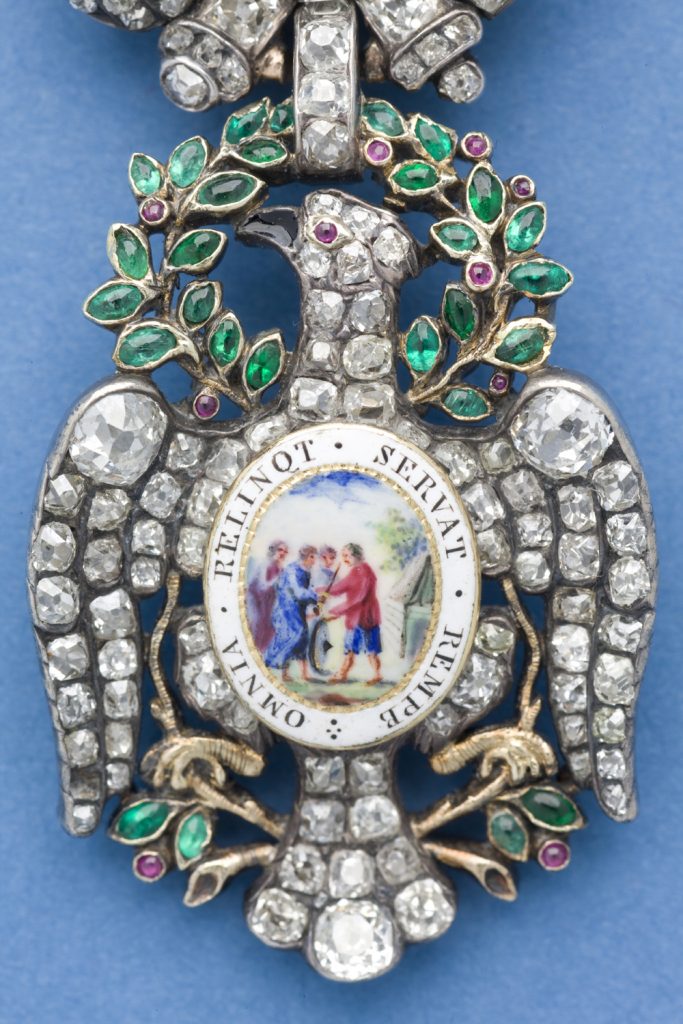
Obverse of the Eagle body
The body of the insignia takes the shape of a bald eagle, with diamonds forming the head, neck, wings, legs and tail. These stones are mounted in silver cups backed with gold. Most of the diamonds in the head, tail and wings are channel set, meaning that they are held in place with a metal rim, or channel, attaching the top edge of the stone to the cup.